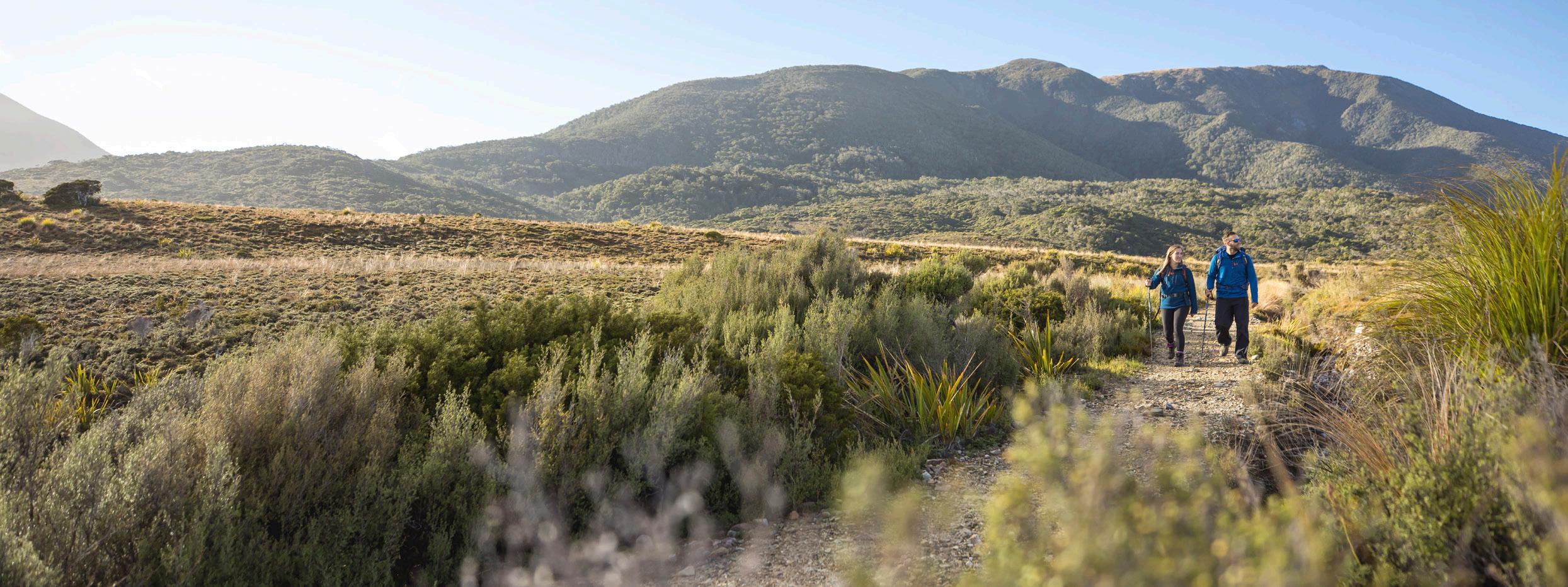Explore New Zealand’s Outdoors
A multi-day hiking trip in New Zealand is one of life’s most incredible experiences. With over 950 backcountry huts and approximately 14,700 kms of tracks, there’s hiking options for everyone. With some specific planning and preparation, and awareness of what’s important to know when hiking in New Zealand, you’ll make memories that’ll last a lifetime.

Follow the NZ Land Safety Code
Five essential steps for staying safe in the outdoors

Multi-day Hikes
THIS INFO SHEET COVERS:
How to prepare for your walk
Essential equipment to bring
What to expect on your walk
Choose the right trip for you
Learn about the route and make sure you have the skills for it.
It’s important to choose a trip that suits you and everyone in your group.
• How long will it take?
• Do you know which way to go?
• Are there any difficult sections?
• Will you need to cross a river?
• Is it suitable for the whole group?
4.
Share your plans and take ways to get help
Telling a trusted person your trip details and taking a distress beacon can save your life.
If someone in the group got hurt or lost on your trip, how would you get help?

• Share your plans with someone you trust before you go. One option is the PlanMyWalk.nz app
• Many tracks in NZ don’t have mobile phone reception, consider taking a distress beacon. Find out more on the other side of this flyer
• Sign every DOC Intentions Book in huts you pass.
In New Zealand, weather can change fast. Check the forecast and change your plans if needed. Weather can make or break a trip. It’s one of the most important things to consider when going into the outdoors.


• Check the weather forecast
• Be prepared for hot and warm weather as well as cold and wet weather on every trip
• Have a back-up plan and be prepared to change your route due to weather or your progress etc.
1. 2. 3. 5.

Pack warm
Prepare for bad weather and an unexpected night out.
Any trip, even if it is short or easy, needs preparation. Packing the right things makes trips safer and more enjoyable.
• Take all the items on the flipside of this flyer
• Some outdoor equipment stores will hire clothing and equipment if you don’t have your own
• Use PlanMyWalk.nz to see the essential gear list for your trip.
Take care of yourself and each other
Eat, drink and rest, stick with your group and make decisions together.
The best way to enjoy your experience in the outdoors and make it home safely is to look out for one another.
• Always stop and wait at every track junction and bridge to ensure you’re still all together
• If someone is struggling, have a break and consider changing plans
• Never split up your group, stay together.
Prepare for all weather Choose the right trip for you Take regular breaks
the free Plan My Walk app
Caring for yourself and the environment
Download
PlanMyWalk.nz
By Mountain Safety Council
Heaphy Track, Kahurangi National Park
the weather
Understand
clothes and extra food
Take care in New Zealand’s outdoors
Help keep NZ’s outdoors beautiful

Follow the Tiaki Promise and Leave No Trace guidelines:

• Take all rubbish home with you and only use designated toilet facilities.
• Respect all wildlife by giving animals space and not feeding them.
• Leave nature undisturbed and never take items away with you.
• Reduce the chance of fire by following fire safety rules.
• You do not require a permit to walk on public tracks. Respect any land owner signage and be considerate of other track users
Be alert in the outdoors
Reduce the risk of getting lost or encountering hazards even on a short walk, stay safe by:
• Following the orange track markers and staying on track. Pay attention to any on-track signs with advice.
• Being observant of where you are on the track and how much further until your destination. Consider how much daylight is left in the day and turn back when needed.
• Never attempt to cross a river that is flooded, take care when deciding if it is safe to cross. Use bridges where possible. Find out more at mountainsafety.org.nz.
Never rely on your mobile phone
Mobile phone coverage (including internet coverage) is very poor in most outdoor areas across NZ and even some small towns in remote areas.
• Tell someone where you are going and when you expect to return. Ensure they know what to do if they don’t hear from you, so make sure you tell them when you are back!
• Always carry your phone on you, turn your phone on Flight Mode to save battery while walking.
• You may get cell service on ridgelines/above the bushline. Consider checking your signal on breaks in these parts of your track if needed.
Staying in huts
New Zealand huts don’t have restaurants or staff available (unless you’re on a guided trip and staying at private lodges).
• There are a wide range of sizes and facilities from two bed shelters to 40+ beds. These require you to bring your own cooker, food, gas and sleeping bags.
• Toilets and water are provided, check signage about what water treatment is required.
• Many huts do not require booking and first come, first served. Check if your chosen hut needs to be booked on doc.govt.nz.
What happens in an emergency situation?
An emergency could include getting lost or an injury where you cannot retreat or carry on.
• Stay where you are and apply first aid if required. Then focus on getting shelter, warmth and have food and water.
• Meanwhile your emergency contact should be aware that you are overdue from your walk. They should try to contact you and others on the trip, then try to contact 111 emergency services. The trip details you provided prior should help emergency services find to you.
• If you have an emergency distress beacon, follow the instructions on the device before entering the outdoors and only use in an emergency. This will send a signal to your exact location to emergency services.

Waterproof jacket Warm hat + gloves Sun protection First aid kit + medication Food and water
Walking poles (suggested for additional support) Headtorch + batteries Sturdy footwear + socks Gaiters Base layer Walking shorts/ pants Thermal top (polypropylene/ merino) Thermal leggings (polypropylene/ merino) Mid-layer insulation Down jacket Waterproof pants Tent or emergency shelte r Survival Kit Map and compass/GPS Toilet paper + rubbish bag Sleeping bag + mat Cooking equipment Mobile phone + Distress beacon (you can rent or buy these) FREE RESOURCES NZ Mountain Safety Council www.mountainsafety.org.nz PLAN FOR YOUR WALK Plan My Walk app www.planmywalk.nz CARE FOR NZ Tiaki Promise www.tiakinewzealand.com Get the information you need to prepare Follow track markers Use bridges where possible Consider carrying a distress beacon First time going on an overnight trip? Continue your research and talk to others before you go.









